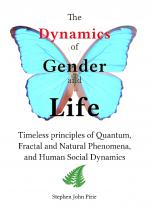[Excerpt Be and Become, © ProCreative, Sydney 2000]
In our normal, everyday world we take for granted the ease with which we can observe the strict correspondence between cause and effect. For example, when we shoot a projectile, such as Zeno’s arrow mentioned earlier, we know that it will basically travel in a straight line, save for the curve of trajectory due to gravity or cross wind.
Overall, when we experience the world of macro-sized things—i.e. the normal physical world, things behave as Newton predicted. As covered in the previous chapter in the section “Prisoners of Light” up to the speed of light, things remain pretty much ordinary.
There appears an upper limit to physical reality in terms of how fast things can go. But what about a lower limit? What happens as we examine smaller and smaller segments of both space and time? What do we find as we come closer and closer to the evasive now-moment? Might we start to see the discontinuity of the space-time continuum, as might be expected from consideration of Zeno’s paradox? The study of things microscopic is where quantum research is largely focused. And it is the observation of things at the microscopic level which has shaken, perplexed and indeed shocked scientists the world over for nearly 80 years.
As can be expected from consideration of the flight of Zeno’s arrow, when particles of microscopic size are fired at a target and we attempt to observe their flight, the particles don’t appear to travel a continuous, predictable trajectory. What initially startled the physicists was that the moment-by-moment detailed trajectory of a particle is in fundamental and unavoidable terms, discontinuous and unpredictable.
To appreciate what happens, let’s first consider what happens in our normal everyday world when we shoot an arrow, or throw a ball. As the ball leaves our hand, or the arrow leaves the bow, we can easily observe the trajectory of the ball or arrow. We do so by focussing our eyes, for example, on the light which is reflected off the travelling ball or arrow. The absence of the reflected light makes observations rather difficult, as you will no doubt appreciate if you’ve ever wondered around in the pitch dark without the aid of a flashlight. But in the world of electrons and atoms, when we attempt to “see” the trajectory of the particle, by bouncing light off the particle, we observe bizarre behavior indeed. Behavior which is so bizarre in fact, that one of the pioneers of quantum physics research, Niels Bohr, as mentioned earlier, once made the rather frank admission that he considered the observed behavior and the implications of that behavior as “shocking.”
It seems that we are generally insulated from observing such shocking behavior because we are, in relative terms, big slow dullards, cocooned within the limited perceptions of our local senses (tuned as they are to the macro-sized world of bears, balls and battle-ships). You might say that the world appears as it does due to our unblinking faith in it. If perhaps we were to blink our eyes fast enough, we might be shocked by what we saw (or didn’t see).
What then specifically are these so-called “shocking” behaviors?
 "The Dynamics of Gender and Life" ebook is now available at
"The Dynamics of Gender and Life" ebook is now available at